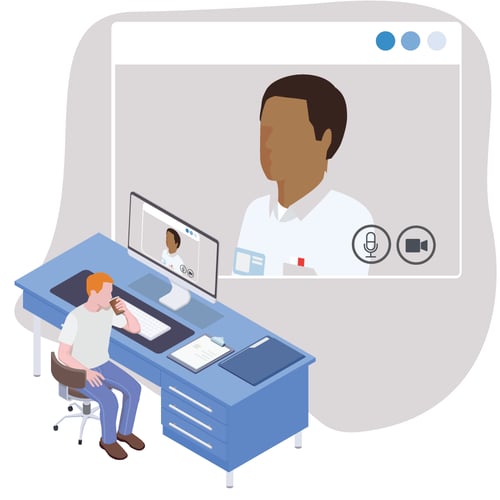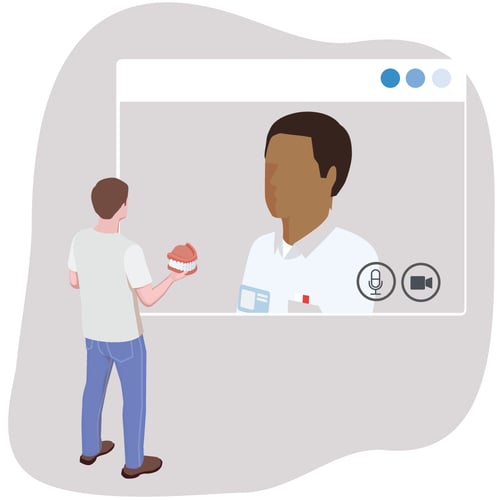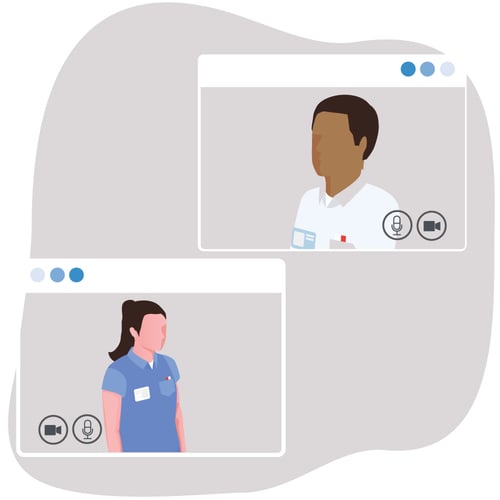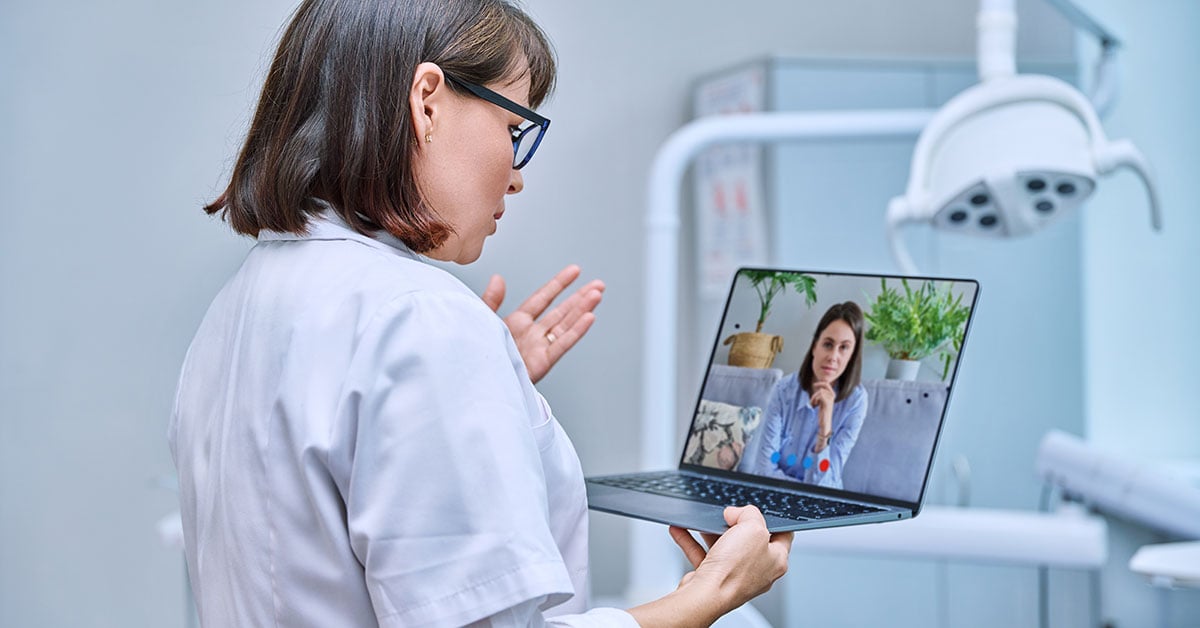Technology has stepped up its game. And with teledentistry it’s scoring points against the downward trend of decreased dental visits.
Whether you’re ready to make the leap or not a teledentistry solution comparison could help you get on board technology that’s likely here to stay.
Reason Enough to Take a Step Back and Evaluate
Time and financial constraints are common reasons the public has postponed dental visits. The American Dental Association confirms those reasons and the fact that 42% don’t visit a dentist as often as necessary.
Teledentistry is a timely solution.
- Remote consultations save time for those with dental issues
- Secure teledentistry platforms allow for an easy, convenient exchange of questions, comments, and digital images that can lead to a diagnosis
- An initial, virtual consultation provides an accurate assessment to confirm the need for an in-person appointment and/or a second opinion
Each of those core aspects of teledentistry provides an introduction to the broader benefits of virtual and/or mobile dental care.
But who’s leading the innovation? And how do the various platforms specifics compare?
Teledentistry Solution Criteria
Each teledentistry leader has across-the-board similarities. But each one also has a “best” benefit they provide.
Before exploring the ins-and-outs there are also points of evaluation common to those listed.
Are they secure?
Virtual health solutions must meet security criteria. All online consults should be private and provide maximum protection for patient data and financials. HIPAA compliance and data encryption are essential components.
How do they communicate?
Preferred communication mode drives many patients to opt for a teledentistry or telehealth visit. Video and phone capabilities for synchronous (real-time) interaction and text (SMS) or email for asynchronous (delayed access) consultations.
Do they value convenience?
Bottom-line: an in-person dental visit requires time. Teledentistry reduces the time constraints.
Patients can schedule appointments on their schedule and later adapt to the potential for an in-person appointment. Mobile app capability is also a strong point of evaluation.
Teledentistry Solution Comparisons
Teledentistry for “Emergency Care”
Certain teledentistry providers fill the emergency care need gap. They provide access to necessary dental care when a local or regional office is closed or unavailable.
Upsides for emergency teledentistry care providers:
- Connects patients with board-certified dentists for 24/7 care
- Some provide free account creation with access via mobile app (iOS and Android) and their website
- Basic, brief consultations are typically available via a flat fee (and by dental insurance if applicable) for symptom review, treatment recommendations, and referral options
- Prescriptions can be ordered if and when necessary with some providers
Downsides to consider:
- Not all providers are available nationwide (including the leading emergency teledentistry providers)
- Full examinations are limited when relying solely on teledentistry for emergency care
- Video and microphone access via a device is required for emergency consultations
Teledentistry with “Educational Resources” built-in
Access to dental care with available answers to common questions is a platform goal for some experienced teledentistry providers.
The upsides of care and informational providers:
- A simple interface via provider’s website or a downloadable mobile app (iOS and Android)
- Opportunity for a free, live chat with an available dentist
- Options for referrals to local dentist(s) as necessary
- Additional assistance provided by direct video consultation with a dentist who can also prescribe medication as necessary
- Access to educational resources about common dental issues without having to speak with a dentist
- Consultation details can vary. Some provide a free initial question inquiry, others charge a small fee for a brief (e.g. 15 minute) video consultation, and a fee increase could occur if an electronic prescription is provided.
Common downsides you might encounter:
- It’s unclear whether some providers allow patients to request/schedule a video consultation or if it’s prompted by the dentist.
- Certain geographic restrictions prevent referrals to local dental providers.
- Limitations of virtual consults could require an in-person diagnosis prior to necessary treatment.
Teledentistry for “Full-Service, 24/7” Access
Patients seeking a full-range of dental care can do so via certain teledentistry provider’s 24/7 access to qualified dental professionals.
Full-service provider upsides include:
- Video or text chat capabilities for dental advice, consultations, and second opinions
- Creation of a personal account allows patients access to send and store files (including images, videos, and x-rays) and to track personal communication and health history data
- Direct video communication with a dentist by appointment or the ability to engage in a virtual “walk-in” chat with an available online dentist
- Referral services are possible pending location availability
- User access via website and a mobile app (confirm availability of iOS or Android)
- Availability of free consultations, prescription services available, and use of insurance coverage (per provider)
Downsides could include:
- State by state restrictions could apply to certain dentist referral opportunities
- Like other teledentistry solutions - a full oral exam might be limited through a virtual consultation. An in-person diagnosis could be necessary.
Teledentistry through “Employee Benefit Programs”
Imagine virtual access to dental care at your workplace or as a workplace provision. Some teledentistry providers offer direct to patient services and a corporate connection through an employer’s benefit program.
The upsides here include:
- Virtual care access via a dedicated platform
- Video calls with a licensed dentist
- Virtual form delivery, billing and insurance review, and payment solutions
- Provisions for prescriptions and in-person follow-up care as necessary
- Depending on the provider - health insurance plans are accepted along with copays and fee payments via credit card or virtual payment portals
Be aware of these model downsides:
- Some teledentistry services might not be available on-demand but rather by appointment only through their account
- On-site preventive services could require additional in-person follow-up or treatment.
Teledentistry within a “Branded Dental” organization
Certain branded dental organizations offer a virtual visit option within their broader in-person services. They provide in-person service with a virtual visit option utilizing a licensed dentist (e.g. Monday through Friday, 9 a.m to 6 p.m.)
The upsides of this model include:
- A free initial virtual visit with a virtual care consultant to determine the necessity of a virtual appointment with a dentist
- Needs assessed during the virtual appointment to deem if an in-person follow-up is required
- A flat fee is typical for a virtual consultation with the organization’s dentist and dental insurance plans being commonly accepted in addition to Health Savings Accounts and Flexible Spending Accounts
Explore their downsides such as:
- Virtual services being limited to regular business hours and would exclude emergencies or on-demand care consultations.
- Confirm all virtual consultation fees as some can be more expensive than others.
Teledentistry for “Niche-Dental Specialities”
Some providers utilize virtual appointments for niche specialties. For example, cosmetic dentistry procedures focusing on tooth and smile appearance, veneers, whitening, restorations, and more could be discussed.
The upsides are:
- Being connected with a cosmetic dentist via video consultation. Patients can upload photos of their teeth and smile, provide a brief explanation of their appearance goals, and ask questions about procedures.
- Receiving a personalized video explanation (asynchronous communication) of treatment options.
- Patients being able to schedule an appointment as the next step to a smile-makeover, etc.
- A typical low-cost or free virtual consultation. Some prices can vary for the next-phase treatment per provider.
Downsides to consider:
- Niche-specialty providers tend to focus more on specific services to the exclusion of general teledentistry services (e.g. emergency or general dental care).
- Access is often limited to those dentists who contract with the service. This can create geographic limitations depending on provider availability.
Teledentistry for “Second Opinions”
Some dental practices can and do utilize teledentistry for providing second opinions.
The upside potential:
- A brief consultation with their provider(s) during regular business hours.
- Virtual visits can be conducted via video conferencing utilizing the patient’s available camera/microphone ready phone, tablet, or computer. Patient privacy and security protocols are followed (e.g. HIPAA, etc)
- An assessment of needs and recommendations for emergency or follow-up care can be provided.
- A patient’s questions and issues related to a variety of dental treatments are allowed in reference to the desire for a second opinion
- Free or low-cost virtual consultations can be provided with the option for insurance to be applied (per insurer).
Downsides to consider:
- Local office schedules might be limited for in-person visits or referral capabilities depending on availability.
- Team capacity might be stretched given patient desire for teledentistry services.
Compare the Solutions Aligned with the Future of Teledentistry - including Teledentix
Innovative teledentistry organizations see the technology platform as more than a passing trend. It’s another effective way to maximize virtual patient interactions that result in better patient care.
Access the following resources for more in-depth insights into how teledentistry is evolving as a patient-care solution:
Guide to a Teledentistry Consultation Network
Teledentistry: Where We Are Now and Where We are Going
The Teledentix platform aligns in scope with the innovators covered covered here.
- Answer a patient’s treatment specific questions
- Confirm procedural details, costs, insurance, and more
- Maximize your production time and team energy










